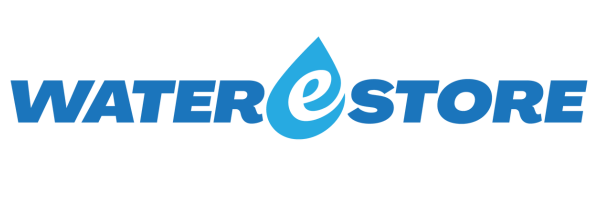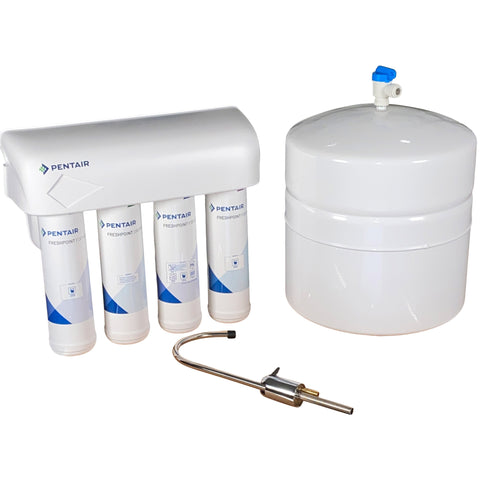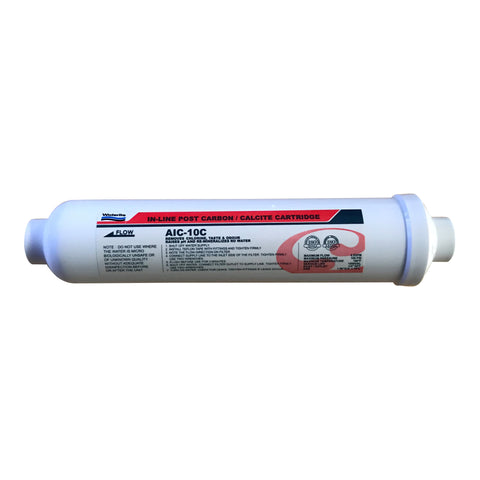
Reverse Osmosis Drinking Water systems look complex, but do you ever wonder how they work? There are all kinds of filters and hoses and a tank, but how can the tank possibly work with only one hose attached?
If you want to learn how a home Reverse Osmosis Drinking Water system produces super pure, great tasting drinking water for your family then follow along!
First, a bit of history. Reverse Osmosis was first invented by the US Navy during World War II to purify sea water into drinking water for use on submarines. So you know that it’s particularly effective at removing minerals like sodium from your water. In fact, up to 95% of the mineral content is removed!
A Reverse Osmosis Drinking Water System is perfect for you if you’re looking for an inexpensive source of "super pure" drinking water for your home. For a Reverse Osmosis (RO) system to operate flawlessly, the raw water needs to be pre-treated to make sure there is no hydrogen sulphide, iron, manganese or hardness present which would quickly foul the membrane.

A Reverse Osmosis system is connected to your cold water plumbing. The process starts out by passing your water through a Sediment Filter to remove dirt particles in your family's water before going through a Carbon Filter to remove chemicals like chlorine or chloramines. People always ask why most Reverse Osmosis Drinking Water Systems have two carbon filters, one right after another -- that’s to give the carbon enough contact time to remove all of those chemicals from your water source.
Then the water is forced through a semi-permeable membrane which allows pure water to pass through it, while rejecting the contaminants that are too large to pass through the tiny pores in the membrane. As this water is being purified, the membrane to continually cleaning itself, washing the rejected contaminants away from the membrane and down the drain.
Because Reverse Osmosis water is produced relatively slowly it needs to be stored in its own small pressure tank to make sure that there will be plenty of water to be dispensed quickly from the faucet for your family. As such, a dedicated faucet is installed at the kitchen sink to dispense the Reverse Osmosis water. If you have a refrigerator with an ice maker and water dispenser, the Reverse Osmosis system can be connected to it also, giving you cold "super pure" water as well as nice clear ice cubes which leave no residue when they melt in your glass.
Oh and to answer your starting question, why does the tank have only water line going to it? There is a “T” connector after the last filter so water can flow either to the tank or the faucet or potentially both. When the tank is filling and no water is being dispensed through the faucet water flows into the tank. When water is flowing to the faucet it primarily comes from the tank with a small amount coming straight from the RO system.

As you can see, High Efficiency Reverse Osmosis Drinking water systems provide super pure and great tasting drinking water for your family.
An RO system provides you with an unlimited premium water supply in your home, and eliminates the wastefulness and environmentally damaging use of single servicing plastic water bottles. It's simply the easiest and most inexpensive way to significantly reduce unwanted mineral and chemical content from your family’s drinking water!
- Need a High Efficiency RO System in your home? Most of our Reverse Osmosis drinking water systems and their replacement filters and membranes are Made in USA and we offer FREE shipping coast to coast in Canada. Whether you are looking for a small inline water filter for your Reverse Osmosis drinking water system or a full set of filters, we have what you need, all at discount prices.
- Looking for our RO customer favourite? The HUM Water Saver 75gpd Reverse Osmosis System is it. This great system offers premium 5-stage water filtration, installs easily under your sink or in your basement, and includes a chrome faucet and all the fittings for easy installation! Check it out here.
- Have an RO unit already? We offer replacement filters for Waterite, Goldline and many other popular brands. Be sure to check out our combo and multipack filters which will save you even more by purchasing a complete set of replacement filters for your Reverse Osmosis Drinking Water System.
Go here for your next video on Reverse Osmosis water filtration and I’ll see you there!
Video Transcript
Gary The Water Guy:
Reverse osmosis drinking water systems look really complex. I mean you've got all these filters down here, you got a filter on top, you've got a membrane, and then when you go up here, you've got all these tubes, all these connectors, and this fitting here, what is that even. How can this possibly work and then you've got a tank with one hose going to the tank. Now how can water go in and out through the same hose? Well if you've ever wondered how a reverse osmosis drinking water system produces super pure reverse osmosis drinking water for your family, you're in the right place, because this video is definitely for you and I'm going to show you how it works starting right now.
Gary The Water Guy:
Hi, I'm Gary The Water Guy and I simplify water filtration to help you conquer crappy water for your family. A bit of history, reverse osmosis was created during the second World War to put drinking water on submarines. Here you've got a submarine with very little storage capacity inside and it's in this huge body of water that no one can drink. So what reverse osmosis does, it reduces the mineral content of water by over 90% so it took all that seawater and made it into drinking water for the sailors on those submarines. The reverse osmosis drinking water system is a great source of super pure reverse osmosis water for your family, and gets you away from all those single-serving water bottles.
Gary The Water Guy:
All right, so a reverse osmosis system like this one here is connected to the plumbing in your home. It's the cold water runs into the system, so you can install this either underneath the kitchen sink or if underneath the kitchen, you have a basement or a crawlspace that's unfinished, you can also install it down there and then just run the tube up to the faucet at the kitchen sink.
Gary The Water Guy:
All right, so the first stage, the water flows in through this side and the first stage is the sediment filter. So it's just one of these polypropylene sediment filters, five microns, and then from there it flows through two carbon filters. They look something like this and the carbon filters remove chemicals from the water. So if you're on a municipal water source, of course the chemical we're talking about here is chlorine or chloramines. If you're on a well water source, you'd be removing other chemicals like herbicides, pesticides, that kind of thing. From there, it's gone through these three filters. Now it heads up to the membrane.
Gary The Water Guy:
So this is what the membrane looks like. There's different brands on the market. This one here comes from Water-Right, but if you look at the end of it, you'll see that it looks like a scroll. So that's where the water comes in, through this side, goes through that scroll, and then from there divides up into two flows. So the good water, the low mineral content water, the stuff that you're going to be drinking, goes to one line, and the high mineral content water, the water that's being used to flush and to keep this membrane clean, goes to the drain line.
Gary The Water Guy:
All right, so then let's look at the plumbing up here. This is the part that always confuses folks and they always have all the questions about. So after it's gone through the filters it comes out here and then it flows across here. Then it goes through this valve here, so this is called an ASO valve. Which stands for automatic shut-off valve. So it compares the pressure going through this and the pressure coming out of it. We'll talk about that a little bit more more a little bit later.
Gary The Water Guy:
Then it flows through here, and then it goes into the membrane. So once it flows into the membrane it goes through the membrane, and then here you can see that there's two outlet ports from there. So this one here, the black outlet port, is being connected to the drain, and this part here is a restrictor valve. So what happens is we have to apply some restriction to make sure that that membrane works efficiently.
Gary The Water Guy:
All right, so that water goes out to the drain, and then this water here, this blue line that you see over here, again goes through the ASO valve. And then it comes through and it goes to this T. Then when it hits the T, it has a ... Like a T, it's like a fork in the road. So now you've got two choices. It can either go this way or it can go through this filter. So this last filter here is a polishing filter. So you can see on this one here, where is it labeled here? Ah, tank, all right. You see up here, it's labeled tank? So this connection here is going to the tank. That's how it's connected to the tank, so as the unit is making water it's storing it in this tank.
Gary The Water Guy:
Now reverse osmosis produces water very slowly. A very, very slow flow rate, and that's why you have the tank. Because it stores the water in the tank. Once the tank fills, it provides back pressure and that back pressure is read through this ASO valve and then it knows when to shut the system off.
Gary The Water Guy:
All right. Then once we've got the water going to the tank, then it comes out of the tank and it heads out through here and this is where it's connected to the faucet. So there's a dedicated faucet like this. It should be a little bit closer there. That's installed typically at the kitchen sink and now if you also have a fridge with a water dispenser in it or an ice maker, you can put a T in that line and connect it up to the fridge too. So you again have super pure reverse osmosis water at the fridge but your ice cubes would be super clear. When they melt you don't have to worry about all that fuzzy little stuff at the bottom of the glass and it will clear all that up.
Gary The Water Guy:
So remember I was talking about the tank and why it only has one hose? So again, when the tank isn't 100% full, water is flowing to the system and it's filling up the tank. But when you call for water from the faucet, or from the fridge or ice maker, then water comes from the tank and goes through there. So that's why this T is all the magic that makes this one hose work at the reverse osmosis tank.
Gary The Water Guy:
So there are different kinds of reverse osmosis systems. So this is a standard efficiency reverse osmosis system here, the GoldLine 50, and then we have the HUM Water Saver 75 which is a high efficiency reverse osmosis system. What's the difference between the two? It's the membrane. The rest of the stuff is pretty much the same. It's just the membrane. So what does high efficiency mean? Is less water being wasted. Remember I said with when the water, it's purifying water, there's some water going to the drain and it's keeping that membrane clean and of course that's the wastewater, the high mineral content water that you don't want to drink that's going to drain. With a system like this, there's more water that goes to the drain. It uses water to produce the reverse osmosis, so there's about three or three and a half gallons of water goes to the drain for every gallon of water you drink where this one is closer to one to one and a half gallons of water goes to the drain for every gallon of water that you and your family drink.
Gary The Water Guy:
So you see, it really wasn't all that complicated after all now was it? Click over here to go over to my next video on reverse osmosis systems and I'll see you there.














